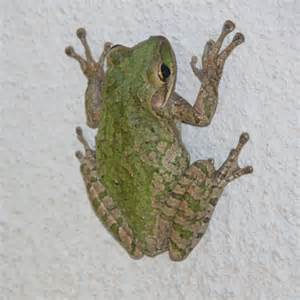In the invasive species world, we talk of “Early Detection Rapid Response” (EDRR). These are invasive species that are currently not in our area, or are in very low numbers, but pose a potential threat. One of these is the Cuban treefrog.
As the name implies, Cuban treefrogs are from Cuba, and arrived in Florida around 1920 mostly likely in cargo ships. With the tropical climate of south Florida, the frogs did well and began to multiple and disperse north. At the beginning of 2022 there were 1,953 records of Cuban treefrogs in the U.S. Currently there are 2,462. There were few records in the Florida panhandle, now there 45 records from 11 of the 16 panhandle counties. They are spreading.

Photo: UF IFAS
In the past many of the invasive species that invade south Florida could not tolerate our winters. That is changing, and we are seeing more here than we have in the past. We have had one off records of Cuban treefrogs from our area over the years but recently there were reports of possible breeding pairs in Panama City, reports from the Crestview area, the Pensacola area, and several from the Milton-Pace area. Just recently they were found at one of the county buildings in Escambia County, in downtown Pensacola, and now near Gulf Breeze. Again… they are coming.
How would you know one when you see it?
First, they are treefrogs. Treefrogs differ in have toe pads at the end of each toe. Second, the adult Cuban treefrogs are much larger than the natives. Most of our native treefrogs are no more than two inches in length. Cuban treefrogs can reach six inches. The juveniles can be distinguished by looking at their belly. The skeleton appears blue through the skin. The skin between the eyes is fused to the skull (will not slide if rubbed with your thumb), and their eyes are reddish in color.
What do I do if I see one?
First, report it to the national database EDDMapS (www.EDDMapS.org). Second, if you are willing, humanely euthanize it. The most humane way to do this is to numb the nervous system first. This can be done by rubbing oral gel in the stomach or cooling them in a cooler with ice. Then they can be frozen.
Why are they a problem?
By definition invasive species DO cause problems. In this case Cuban treefrogs they are known to consume native frogs, wiping them out of many areas in the state. Like most invasive species, they reproduce at high rates and have few predators. One story came from a USGS biologist in Louisiana. He received a call from the Audubon Zoo in New Orleans stating they had ordered palm trees from a south Florida nursery for one of their exhibits. After a couple of days, the caretakers noticed numerous frogs they had not seen before. The biologist had an idea of what they might be and drove over. When he arrived, he decided to check the electric panel by the male restroom – Cuban treefrogs are known to reside here and sometimes short circuit systems. He opened the panel to find 30 Cuban treefrogs inside. Game on. New Orleans now has Cuban treefrogs.
By the way, this is a common method of dispersal – hitchhiking on plants from south Florida to nurseries and stores in our neck of the woods. Our winters are milder than they once were, and they seem to be overwintering and breeding. So, game on for us here in the panhandle as well.
If you think you may have a Cuban treefrog contact your county extension office to verify identification before you try to remove them. We certainly do not want harmless native species to get caught up in this management effort. If you have any questions, contact your county extension office.



